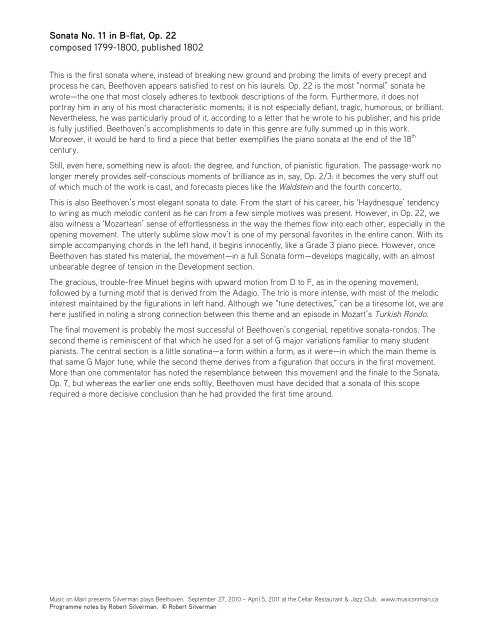beethoven's 32 piano sonatas robert silverman - Music on Main
beethoven's 32 piano sonatas robert silverman - Music on Main
beethoven's 32 piano sonatas robert silverman - Music on Main
Create successful ePaper yourself
Turn your PDF publications into a flip-book with our unique Google optimized e-Paper software.
S<strong>on</strong>ata No. 11 in B-flat, Op. 22<br />
composed 1799-1800, published 1802<br />
This is the first s<strong>on</strong>ata where, instead of breaking new ground and probing the limits of every precept and<br />
process he can, Beethoven appears satisfied to rest <strong>on</strong> his laurels. Op. 22 is the most “normal” s<strong>on</strong>ata he<br />
wrote—the <strong>on</strong>e that most closely adheres to textbook descripti<strong>on</strong>s of the form. Furthermore, it does not<br />
portray him in any of his most characteristic moments; it is not especially defiant, tragic, humorous, or brilliant.<br />
Nevertheless, he was particularly proud of it, according to a letter that he wrote to his publisher, and his pride<br />
is fully justified. Beethoven’s accomplishments to date in this genre are fully summed up in this work.<br />
Moreover, it would be hard to find a piece that better exemplifies the <str<strong>on</strong>g>piano</str<strong>on</strong>g> s<strong>on</strong>ata at the end of the 18 th<br />
century.<br />
Still, even here, something new is afoot: the degree, and functi<strong>on</strong>, of pianistic figurati<strong>on</strong>. The passage-work no<br />
l<strong>on</strong>ger merely provides self-c<strong>on</strong>scious moments of brilliance as in, say, Op. 2/3: it becomes the very stuff out<br />
of which much of the work is cast, and forecasts pieces like the Waldstein and the fourth c<strong>on</strong>certo.<br />
This is also Beethoven’s most elegant s<strong>on</strong>ata to date. From the start of his career, his ‘Haydnesque’ tendency<br />
to wring as much melodic c<strong>on</strong>tent as he can from a few simple motives was present. However, in Op. 22, we<br />
also witness a ‘Mozartean’ sense of effortlessness in the way the themes flow into each other, especially in the<br />
opening movement. The utterly sublime slow mov’t is <strong>on</strong>e of my pers<strong>on</strong>al favorites in the entire can<strong>on</strong>. With its<br />
simple accompanying chords in the left hand, it begins innocently, like a Grade 3 <str<strong>on</strong>g>piano</str<strong>on</strong>g> piece. However, <strong>on</strong>ce<br />
Beethoven has stated his material, the movement—in a full S<strong>on</strong>ata form—develops magically, with an almost<br />
unbearable degree of tensi<strong>on</strong> in the Development secti<strong>on</strong>.<br />
The gracious, trouble-free Minuet begins with upward moti<strong>on</strong> from D to F, as in the opening movement,<br />
followed by a turning motif that is derived from the Adagio. The trio is more intense, with most of the melodic<br />
interest maintained by the figurati<strong>on</strong>s in left hand. Although we “tune detectives,” can be a tiresome lot, we are<br />
here justified in noting a str<strong>on</strong>g c<strong>on</strong>necti<strong>on</strong> between this theme and an episode in Mozart’s Turkish R<strong>on</strong>do.<br />
The final movement is probably the most successful of Beethoven’s c<strong>on</strong>genial, repetitive s<strong>on</strong>ata-r<strong>on</strong>dos. The<br />
sec<strong>on</strong>d theme is reminiscent of that which he used for a set of G major variati<strong>on</strong>s familiar to many student<br />
pianists. The central secti<strong>on</strong> is a little s<strong>on</strong>atina—a form within a form, as it were—in which the main theme is<br />
that same G Major tune, while the sec<strong>on</strong>d theme derives from a figurati<strong>on</strong> that occurs in the first movement.<br />
More than <strong>on</strong>e commentator has noted the resemblance between this movement and the finale to the S<strong>on</strong>ata,<br />
Op. 7, but whereas the earlier <strong>on</strong>e ends softly, Beethoven must have decided that a s<strong>on</strong>ata of this scope<br />
required a more decisive c<strong>on</strong>clusi<strong>on</strong> than he had provided the first time around.<br />
<str<strong>on</strong>g>Music</str<strong>on</strong>g> <strong>on</strong> <strong>Main</strong> presents Silverman plays Beethoven. September 27, 2010 – April 5, 2011 at the Cellar Restaurant & Jazz Club. www.music<strong>on</strong>main.ca<br />
Programme notes by Robert Silverman. © Robert Silverman


